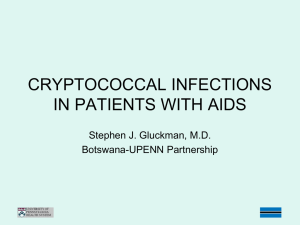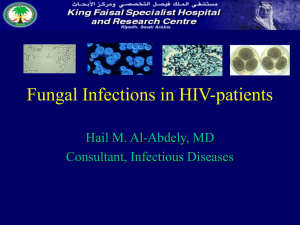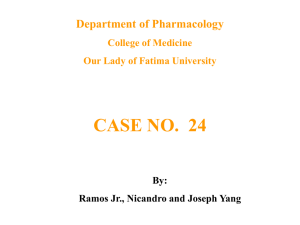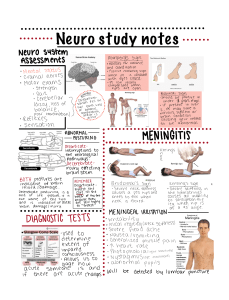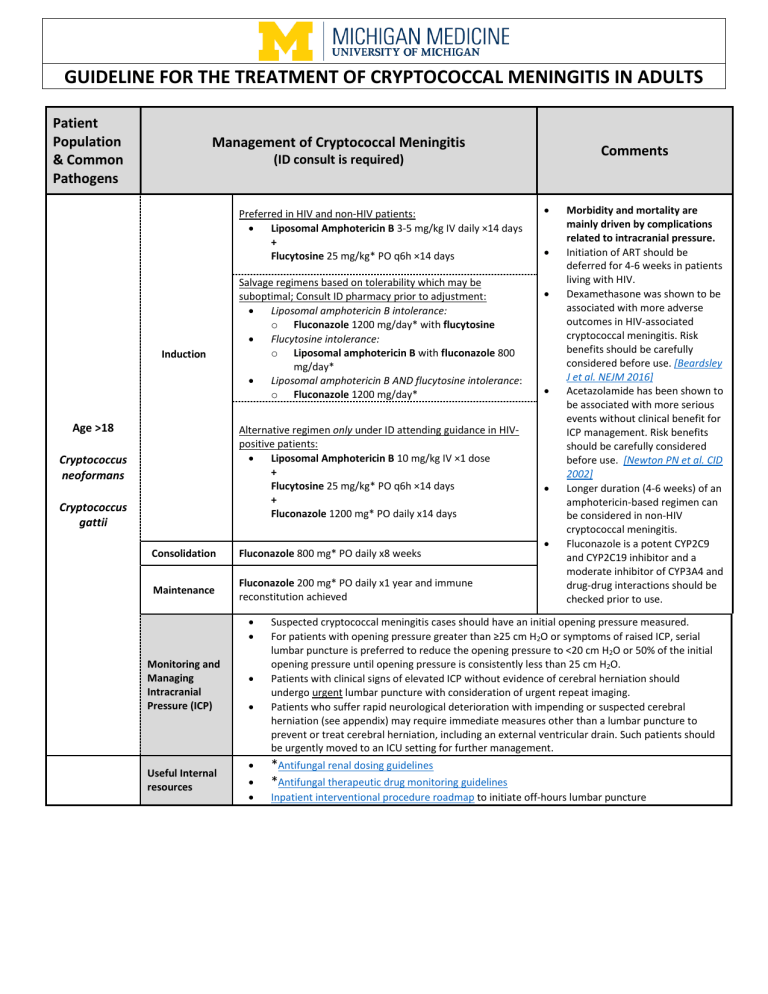
GUIDELINE FOR THE TREATMENT OF CRYPTOCOCCAL MENINGITIS IN ADULTS Patient Population & Common Pathogens Management of Cryptococcal Meningitis Comments (ID consult is required) Preferred in HIV and non-HIV patients: • Liposomal Amphotericin B 3-5 mg/kg IV daily ×14 days + Flucytosine 25 mg/kg* PO q6h ×14 days Induction Age >18 Salvage regimens based on tolerability which may be suboptimal; Consult ID pharmacy prior to adjustment: • Liposomal amphotericin B intolerance: o Fluconazole 1200 mg/day* with flucytosine • Flucytosine intolerance: o Liposomal amphotericin B with fluconazole 800 mg/day* • Liposomal amphotericin B AND flucytosine intolerance: o Fluconazole 1200 mg/day* Alternative regimen only under ID attending guidance in HIVpositive patients: • Liposomal Amphotericin B 10 mg/kg IV ×1 dose + Flucytosine 25 mg/kg* PO q6h ×14 days + Fluconazole 1200 mg* PO daily x14 days Cryptococcus neoformans Cryptococcus gattii Consolidation Fluconazole 800 mg* PO daily x8 weeks Maintenance Fluconazole 200 mg* PO daily x1 year and immune reconstitution achieved • • Monitoring and Managing Intracranial Pressure (ICP) Useful Internal resources • • • • • • • • • • • Morbidity and mortality are mainly driven by complications related to intracranial pressure. Initiation of ART should be deferred for 4-6 weeks in patients living with HIV. Dexamethasone was shown to be associated with more adverse outcomes in HIV-associated cryptococcal meningitis. Risk benefits should be carefully considered before use. [Beardsley J et al. NEJM 2016] Acetazolamide has been shown to be associated with more serious events without clinical benefit for ICP management. Risk benefits should be carefully considered before use. [Newton PN et al. CID 2002] Longer duration (4-6 weeks) of an amphotericin-based regimen can be considered in non-HIV cryptococcal meningitis. Fluconazole is a potent CYP2C9 and CYP2C19 inhibitor and a moderate inhibitor of CYP3A4 and drug-drug interactions should be checked prior to use. Suspected cryptococcal meningitis cases should have an initial opening pressure measured. For patients with opening pressure greater than ≥25 cm H2O or symptoms of raised ICP, serial lumbar puncture is preferred to reduce the opening pressure to <20 cm H2O or 50% of the initial opening pressure until opening pressure is consistently less than 25 cm H2O. Patients with clinical signs of elevated ICP without evidence of cerebral herniation should undergo urgent lumbar puncture with consideration of urgent repeat imaging. Patients who suffer rapid neurological deterioration with impending or suspected cerebral herniation (see appendix) may require immediate measures other than a lumbar puncture to prevent or treat cerebral herniation, including an external ventricular drain. Such patients should be urgently moved to an ICU setting for further management. *Antifungal renal dosing guidelines *Antifungal therapeutic drug monitoring guidelines Inpatient interventional procedure roadmap to initiate off-hours lumbar puncture Select References 1. 2. 3. 4. 5. 6. 7. 8. Perfect JR, Dismukes WE, Dromer F, et al. Clinical Practice Guidelines for the Management of Cryptococcal Disease: 2010 Update by the Infectious Diseases Society of America. Clinical Infectious Diseases. 2010;50(3):291-322. Guidelines for diagnosing, preventing and managing cryptococcal disease among adults, adolescents and children living with HIV. https://www.who.int/publications-detail-redirect/9789240052178 van der Horst CM, Saag MS, Cloud GA, et al. Treatment of cryptococcal meningitis associated with the acquired immunodeficiency syndrome. National Institute of Allergy and Infectious Diseases Mycoses Study Group and AIDS Clinical Trials Group. N Engl J Med. 1997;337(1):15-21. Jarvis JN, Lawrence DS, Meya DB, et al. Single-Dose Liposomal Amphotericin B Treatment for Cryptococcal Meningitis. N Engl J Med. 2022;386(12):11091120. Molloy SF, Kanyama C, Heyderman RS, et al. Antifungal Combinations for Treatment of Cryptococcal Meningitis in Africa. New England Journal of Medicine. 2018;378(11):1004-1017. Pappas PG. Managing cryptococcal meningitis is about handling the pressure. Clin Infect Dis. 2005;40(3):480-482 Beardsley J, Wolbers M, Kibengo FM, et al. Adjunctive Dexamethasone in HIV-Associated Cryptococcal Meningitis. N Engl J Med. 2016;374(6):542-554. Newton PN, Thai LH, Tip NQ, et al. A randomized, double-blind, placebo-controlled trial of acetazolamide for the treatment of elevated intracranial pressure in cryptococcal meningitis. Clin Infect Dis. 2002;35(6):769-772. Appendix: Signs and symptoms of elevated intracranial pressure (ICP) Symptoms of elevated intracranial pressure (ICP) include: • Headache: often severe, persistent, and worse in the morning or with a change in position. • Nausea and vomiting: especially in the morning or when the headache is severe. • Vision changes: blurred or double vision, transient visual obscurations, or a "graying out" of vision. • Papilledema: swelling of the optic disc due to increased pressure, detected during an eye exam. • Altered level of consciousness: drowsiness, confusion, or lethargy. • Balance and coordination issues: difficulty walking, clumsiness, or ataxia. • Personality or cognitive changes: irritability, memory loss, or difficulty concentrating. Note that symptoms may vary depending on the underlying cause and severity of the elevated ICP. Clinical signs of impending herniation include: • Rapid deterioration in level of alertness, • Significant pupillary asymmetry, unilateral or bilateral fixed and dilated pupils, • Decorticate (flexion) or decerebrate (extension) posturing, • Respiratory depression, • "Cushing triad" of hypertension, bradycardia, and irregular respiration. • Seizures: Patients who suffer herniation may develop reflexive movements that mimic seizures, and seizures may increase ICP and worsen herniation. This is a neurological emergency. Antimicrobial Subcommittee Approval: P&T Approval: Revision History: 5/2023 6/2023 Originated: Last Revised: 05/2023 06/2023 The recommendations in this guide are meant to serve as treatment guidelines for use at Michigan Medicine facilities. If you are an individual experiencing a medical emergency, call 911 immediately. These guidelines should not replace a provider’s professional medical advice based on clinical judgment, or be used in lieu of an Infectious Diseases consultation when necessary. As a result of ongoing research, practice guidelines may from time to time change. The authors of these guidelines have made all attempts to ensure the accuracy based on current information, however, due to ongoing research, users of these guidelines are strongly encouraged to confirm the information contained within them through an independent source. If obtained from a source other than med.umich.edu/asp, please visit the webpage for the most up-to-date document. Page 2 of 2
